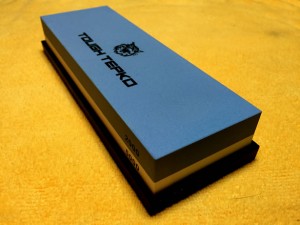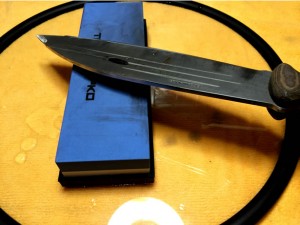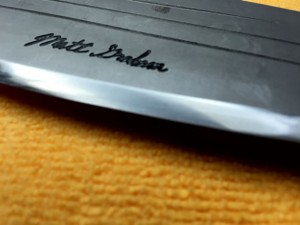Tough Tepko Whetstone Reviewed

Marketing from Tough Tepko
Tough Tepko whetstones were created to give you best performing blades you need to get work done. When performing a task you need your tools to be working perfectly.
Tough Tepko understands that need.
Manufacturer: Tough Tepko, toughtepko
Model: Whetstone #2000, #5000Material: White/Blue Corundum
Grit: 2000# / 5000#
Size: 7″ x 2.37″ x 1.14″ (17.78 x 6.03 x 2.8 cm)
Weight: 20.9 ozAccessories: Silica Gel Non-slip Base
MSRP: $61.00
The Review
All knives need sharpening at some point. One method for sharpening them that has been gaining popularity lately with collectors and enthusiasts alike is the whetstone. I was recently contacted by Tough Tepko to review their new two-sided #2000/#5000-grit whetstone and report my findings…
 Whetstones are a highly-effective way to sharpen blades with difficult grind angles to sharpen like flat and Scandinavian grinds that do not have a secondary bevel. Sharpening solutions that alter the geometry of the blade grind, concave or convex can ruin true flat and Scandinavian grinds, making the bevel nearly impossible to recover.
Whetstones are a highly-effective way to sharpen blades with difficult grind angles to sharpen like flat and Scandinavian grinds that do not have a secondary bevel. Sharpening solutions that alter the geometry of the blade grind, concave or convex can ruin true flat and Scandinavian grinds, making the bevel nearly impossible to recover.
Whetstones are not called whetstones because they are used with oil or water. The name actually comes from the verb, whet which basically means to sharpen by rubbing on or with something such as a stone [To whet a knife].
Tough Tepko whetstones are made from a white and blue layer of aluminium oxide (corundum) bonded together in a double-sided configuration with 2000# grit on one side, and 5000# grit on the other. Bonded abrasives like this tend to provide a faster cutting action than natural stones. The stone is 7″ long, 2.30″ wide and 1.1″ thick and comes with a durable silica gel non-slip base. Stones this size are often referred to as bench stones. It fits snuggly inside the base to prevent the stone from sliding around while you are using it.
Whetstones must be lubricated to keep the pores of the stone free from clogging by lifting the swarf and turning it into a polishing slurry. It also cools the edge of the blade during the cutting action. Water is usually the preferred lubricant, but a food-grade honing oil can be just as effective. However, once a stone has been used with oil, it can never be used with water without drawing all of the oil out of the stone by boiling it first, a long and messy process.
Functional Testing
To put the Tough Tepko whetstone to the test, I brought out one of my Condor Primitive Bush Knives to sharpen. It has an 8″ blade made from 420HC stainless steel with a modified Scandi-grind.
To prepare my workspace for sharpening with a whetstone lubricated with water, I grabbed a 12″ glass disc that I picked up from EdgePro because it is such a perfect tray for working with water. I also grabbed a couple of terrycloth towels and plastic container large enough to submerge the whetstone.
 I added a couple of inches of water into the plastic container and submerged the stone. It began bubbling up immediately as the air was released and replaced with water. I’ve heard 5-10 minutes is plenty of time, while others say at least an hour. However, since the stone was new, I figured about 30 minutes would be more than enough time for the bubbles to stop completely.
I added a couple of inches of water into the plastic container and submerged the stone. It began bubbling up immediately as the air was released and replaced with water. I’ve heard 5-10 minutes is plenty of time, while others say at least an hour. However, since the stone was new, I figured about 30 minutes would be more than enough time for the bubbles to stop completely.
After 30 minutes or so, I placed the stone in the silica gel base with coarser of the two sides facing up. The edge of the blade was already pretty sharp, but it did need a little tuning so starting with #2000 grit might not be a problem. Usually, I like to start with something around #600 to #1000 and move up from there if the edge is not too bad, and start with #240 if it needs a lot of work.
Most knives have a beveled edge somewhere between 10° and 30°. With large flat stones like this, you simply match the angle of the bevel and proceed to sharpen the blade. It is important to use the entire surface of stone as much as possible to keep the stone flat so it will remain consistent over its lifetime. For Scandi and flat grinds without a secondary bevel, the bevel angle is usually very profound making it easy to find and polish.
For the purposes of this test, I followed a forward movement technique similar to the method that Ray Mears teaches in his online videos. I also chose not use a Nagura stone this time around.
I proceeded to sharpen with the #2000 grit side, alternating each side of the blade until I could see an even color along both beveled edges. I started with 20 passes on each side of the blade, gradually reducing the number of iterations until I was alternating sides of the blade on every pass. I kept this up until I could see an evenly colored shine begin to show along the entire beveled edge.
It is very important to add a few drips of water as you go to keep the slurry loose. It needs to stay wet enough that it will float on the surface of the stone and won’t become sticky.
 Once I was finished with #2000 grit side, I washed the slurry off the blade and stone before flipping the stone over to the #5000 grit side and continuing to sharpen the blade. I alternated each side of the blade using the same technique as before, starting with 20 passes, gradually reducing the count until I was alternating sides on every pass.
Once I was finished with #2000 grit side, I washed the slurry off the blade and stone before flipping the stone over to the #5000 grit side and continuing to sharpen the blade. I alternated each side of the blade using the same technique as before, starting with 20 passes, gradually reducing the count until I was alternating sides on every pass.
After spending some time on both sides of the stone, I was able to achieve an even polished finish along the entire blade’s edge for hair-popping results.
Cleaning the stones after each use is very important in order to keep them in tip-top shape. The swarf will clog the pores of the stone and begin to rust almost immediately if you let it sit. The surface of each stone needs to be scrubbed thoroughly with a soft brush and left to air dry so they won’t mildew.
Final Thoughts
The Tough Tepko whetstone is well made from quality corundum that cuts cleanly, but does not wear fast so it remains very flat provided you use the entire surface as you sharpen. The only issue that I found was that there was only a single stone available. Personally, I feel that a #400 / #1000 grit combination stone is needed, at least for survival-style knives because they tend to take more abuse and need more help at the lower-end. But for culinary applications, the single stone with the two high-count abrasive surfaces would likely be sufficient, and maybe even adding a Nagura stone to achieve mind-bending results.
While it does take a lot of practice and patience to work with whetstones, the results that they can provide is astonishing. Personally, I find using them very therapeutic. This whetstone is very affordable and will last for many years if they are properly taken care of. For those open to a manual sharpening solution, this stone is definitely worth a closer look. Thumbs up in my book!
![]()
About Tough Tepko
 Tough Tepko respects tradition by nurturing and reviving old fashioned styles of knife sharpening.
Tough Tepko respects tradition by nurturing and reviving old fashioned styles of knife sharpening.
Tough Tepko respects nature. Whetstones are organic stones and therefore nature friendly.
--